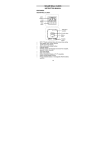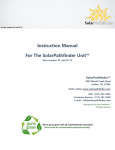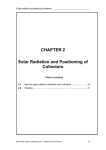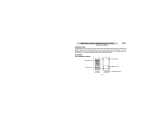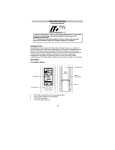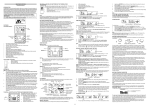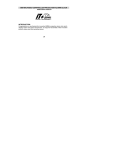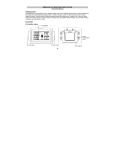Download WS-8117 Instruction Manual
Transcript
868MHZ WEATHER WALL CLOCK Instruction Manual « Instant Transmission+» is the up and coming state-of-the-art new wireless transmission technology, exclusively designed and developed by LA CROSSE TECHNOLOGY. “IT +” offers you an immediate update of all your outdoor data measured from the transmitters: follow your climatic variations in real-time! FEATURES: WEATHER WALL CLOCK: Hanging holes LCD1 display Function keys LCD2 display Battery cover LCD3 display Foldable stand • • • • • • DCF-77 Radio controlled time with manual setting option Time display: hour, minute, second Alarm setting with snooze function Calendar display Weekday display (3 languages to choose from: German, English, and French) Weather forecasting with 3 weather icons 17 • • • • • • • Weather tendency indicator Time zone setting ºC or ºF temperature display selectable Indoor temperature display Wireless transmission at 868 MHz Signal reception intervals at 4 seconds Wall mount or freestanding TEMPERATURE TRANSMITTER: • • • Remote transmission of outdoor temperature to weather station by 868 MHz signal Wall mounting case Mounting at a sheltered place. Avoid direct rain and sunshine TO INSTALL AND REPLACE BATTERIES IN THE WEATHER WALL CLOCK The weather wall clock uses 2 x AA, IEC LR6, 1.5V batteries. To install and replace the batteries, please follow the steps below: 1. Insert finger or other solid object in the space at the bottom center of the battery compartment and lift up to remove the cover. 2. Insert batteries observing the correct polarity (see marking inside battery compartment). 3. Replace compartment cover. TO INSTALL AND REPLACE BATTERIES IN THE TEMPERATURE TRANSMITTER The transmitter uses 2 x AA, IEC LR6, 1.5V batteries. To install and replace the batteries, please follow the steps below: 1. Remove the cover. 2. Insert the batteries, observing the correct polarity (see marking inside battery compartment). 3. Replace the battery cover on the unit. 18 SETTING UP: 1. 2. 3. 4. 5. 6. 7. 8. Insert the 2 x AA, IEC LR6, 1.5V batteries into the transmitter (See “To install and replace batteries in the Temperature Transmitter” above). Within 2 minutes, insert 2 x AA, IEC LR6, 1.5V batteries into the Weather wall clock as indicated above (see "To install and replace batteries in the Weather wall clock“ above). Once the batteries are in place, all segments of the LCD will light up briefly and a brief bip sound will be hear. Then the indoor and outdoor temperature - -.-°C, the time as 0:00, the date as 1/1, and weekday will be displayed. Do not press any buttons for 10 minutes The Weather wall clock will start receiving data from the transmitter. The remote temperature will then be displayed on the Weather wall clock. If the outdoor temperature is not displayed 60 seconds after inserting the batteries into the receiver, all batteries are needed to be removed and wait for at least 1 minute for reset from step 1. The DCF time code reception will automatically start. This takes typically between 3 - 5 minutes in good conditions. This time period is an excellent opportunity to locate the transmitter in suitable location outdoors. In order to ensure sufficient 868MHz transmission however, this should under good conditions be no more than 100 meters from where the Weather wall clock will be finally positioned (see notes on “Positioning” and “868MHz Reception”). If after 10 minutes the DCF time has not been received, use the SET key to manually enter the set mode and change either the time or date in order to activate the DCF reception. The clock will then automatically attempt to receive the DCF time every full hour each day. When this is successful, the received time will override the manually set time. The date is also updated with the received time (Please refers to notes on “DCF Radio controlled time” and “Manual time setting”). The indoor temperature will be measured after the DCF reception. Note: In the event of changing batteries of the unit ensure that the batteries do not spring free from the contacts. Always wait at least 1 minute after removing the batteries before reinserting, otherwise start up and transmission problems may occur. FUNCTION KEYS The weather wall clock has four easy to use keys: SET key : To enter into the set mode for the following functions: L time zone, language, manual time setting, year, month, day, weekday, and ºC or ºF temperature display + key : To toggle between the weekday/date, alarm time, or second display To change the values in manual set mode 19 ALM key : To enter into the alarm set mode To set the alarm ON/OFF SNZ key : To activate the snooze function during alarm To exit any setting modes WEATHER WALL CLOCK LCD SCREEN DESCRIPTIONS The weather wall clock's LCD is divided into 3 sections and once the batteries are inserted, all the segments will light up briefly before displaying the information for time, date, weather forecast, indoor and outdoor temperatures. Alarm icon Weekday Date Radio reception icon DCFTime Low battery icon (transmitter) Indoor temperature Outdoor temperature display Low battery icon (wall clock) Weather tendency and weather forecast icons Sensor signal reception icon* * When the signal is successfully received by the Weather Station, the icon will be switched on. (If not successful, the icon will not be shown in LCD) So the user can easily see whether the last reception was successful (icon on) or not (icon off). RADIO CONTROLLED TIME: The time base for the radio controlled time is a Cesium Weather wall clock operated by the Physikalisch Technische Bundesanstalt Braunschweig, which has a time deviation of less than one second in one million years. The time is coded and transmitted from Mainflingen near Frankfurt via frequency signal DCF-77 (77.5 kHz) and has a transmitting range of approximately 1,500 km. Your 20 radio-controlled Weather Station receives this signal and converts it to show the precise time in summer or wintertime. The quality of the reception depends greatly on the geographic location. In normal cases, there should be no reception problems within a 1500km radius of Frankfurt. Once the outdoor temperature is displayed on the Weather station, the DCF tower icon in the clock display will start flashing in the upper left corner. This indicates that the clock has detected that there is a radio signal present and is trying to receive it. When the time code is received, the DCF tower becomes permanently lit and the time will be displayed. DCF reception is done twice daily at 02:00 and 03:00 am. If the reception is not successful at 02:00 am, then the next reception takes place the next hour and so on until 06:00am, or until the reception is successful. If the reception is not successful at 06:00 am, then the next attempt will take place the next day at 02:00 am. If the tower icon flashes, but does not set the time or the DCF tower does not appear at all, then please take note of the following: • Recommended distance to any interfering sources like computer monitors or TV sets is a minimum of 1.5 - 2 metres. • Within ferro-concrete rooms (basements, superstructures), the received signal is naturally weakened. In extreme cases, please place the unit close to a window and/ or point its front or back towards the Frankfurt transmitter. • During nighttime, the atmospheric disturbances are usually less severe and reception is possible in most cases. A single daily reception is adequate to keep the accuracy deviation below 1 second. MANUAL SETTINGS Note: If the weather wall clock has already successfully received the DCF time signal and displays the correct time and date, then the Manual settings can be skipped. After completion of the above described procedures in “Setting up” the manual setting modes can be entered by pressing the SET key. The following settings can now be programmed: • Time zone setting • Language display setting • Manual time setting • Year setting • Month setting • Day setting 21 • • Weekday setting ºC or ºF setting TIME ZONE SETTING The time zone can be set in LCD1 between the 0 to -12 hour and then runs from 12 back to 0 in consecutive 1-hour interval. To do this: Flashing 1. 2. 3. The current time zone value starts flashing. Use the + key to set the time zone. The range runs from 0 to -12 and then runs from 12 back to 0 in consecutive 1-hour interval. Press and release the SET key to enter the “Language Setting”. LANGUAGE SETTING The weekdays can be displayed in LCD2 with the pre-set languages: German =d , US English = US, French = F. Flashing 1. 2. Set the desired language for the weekday display in LCD 2 by use of the + key. Press and release the SET key to enter the mode “Manual time setting”. MANUAL TIME SETTING In case the weather wall clock is not able to detect the DCF-signal (disturbances, transmitting distance, etc.), the time can be manually set. The clock will then work as a normal Quartz clock. Minutes flashing Hour flashing 1. 2. The hour digits will start flashing on LCD2. Set the desired hours by pressing and releasing the + key followed by pressing the SET key. 22 3. 4. 5. Now the minute digits will start flashing. Set the desired minutes by pressing and releasing the + key . If the + key is held, the units will increase by 5. Press and release the SET key to move to the “Year Setting”. Note: The unit will still try and receive the signal despite it being manually set. When it does receive the signal, it will change the manually set time into the received time. During reception attempts the DCF tower icon will flash. If reception has been unsuccessful, then the DCF tower icon will not appear but reception will still be attempted the following day. YEAR SETTING The year can be selected sequentially from 2001 to 2029 and will then start over again (default setting 2006). Flashing 1. 2. The year digits will start flashing on LCD1. Select the desired year by use of the + key. Press and release the SET key to switch to the “Month Setting”. MONTH SETTING Flashing 1. 2. The month digits on LCD2 will start flashing (Default setting 1). Set the desired month by use of the + key. Press and release the SET key to move to the mode “Date Setting”. DAY SETTING Flashing 1. The digits for the day will start flashing on LCD1 (Default setting 1). Set the desired day by use of the + key. 23 2. Note: The data can only be set in conjunction with the selected month. For example, it is not possible to set the data 30 if the months of February is selected. Press and release the SET key to exit the setting mode and switch back to the normal display mode. WEEKDAY SETTING Flashing 1. 2. The weekday will start flashing in LCD1. Select the desired weekday display by use of the + key. Press and release the SET key to enter the “ºC/ºF Temperature Setting”. °C OR °F TEMPERATURE SETTING Flashing 1. 2. The characters “°C” or “°F” will start flashing on LCD1 (Default setting °C). By use of the + key select “°C” for temperature display in degrees Celsius or “°F” for degrees Fahrenheit. Press and release the SET key to enter the mode “Manual Time Setting”. EXIT THE MANUAL SETTING MODES • • To return to the normal display mode from anywhere in manual setting mode simply press the SNZ key anytime. If no keys are pressed for about 15 seconds in setting mode, the weather wall clock will automatically switch back to normal display mode. ALARM SETTING To enter into the alarm setting mode: 1. Hold the ALM key for 2 seconds. The hour digits start flashing. 2. Press the + key to set the hour. 3. Press and release the ALM key to set the minutes. The minute digits start flashing. 4. Press and release the + key to set the minutes. If the + key is held, the unit will increase by 5. 5. Press and release again the ALM key to exit the Alarm setting mode or wait for 15 seconds automatic timeout. 24 TO DEACTIVATE THE ALARM: Alarm icon (((•))) (ON) The alarm will be automatically ON when the alarm time is set. To deactivate the alarm (OFF), press and release once the ALM key in normal mode display. The alarm icon will disappear, the alarm is now off. SNOOZE SETTING The snooze can only be activated during alarm time for a snooze duration of 10 minutes by pressing the SNZ key on the back of the clock THE WEATHER FORECASTING ICONS: There are 3 weather icons on the middle section of LCD3, which can be displayed in any of the following combinations: SUNNY CLOUDY WITH SUNNY INTERVALS RAINY For every sudden or significant change in the air pressure, the weather icons will update accordingly to represent the change in weather. If the icons do not change, then it means either the air pressure has not changed or the change has been too slow for the Weather Station to register. However, if the icons displayed is a sun or raining cloud, there will be no change of icon if the weather gets any better (with sunny icon) or worse (with rainy icon) since the icons are already at their extremes. The icons displayed forecasts the weather in to terms of getting better or worse and not necessarily sunny or rainy as each icon indicates. For example, if the current weather is cloudy and the rainy icon is displayed, it does not mean that the product is faulty because it is not raining. It simply means that the air pressure has dropped and the weather is expected to get worse but not necessarily rain. Note: 25 After setting up, readings for weather forecasts should be disregarded for the next 12-24 hours. This will allow sufficient time for the Weather Station to collect air pressure data at a constant altitude and therefore result in a more accurate forecast. Common to weather forecasting, absolute accuracy cannot be guaranteed. The weather forecasting feature is estimated to have an accuracy level of about 75% due to the varying areas the Weather Station has been designed for use in. In areas that experience sudden changes in weather (for example from sunny to rain), the Weather Station will be more accurate compared to use in areas where the weather is stagnant most of the time (for example mostly sunny). If the Weather Station is moved to another location significantly higher or lower than its initial standing point (for example from the ground floor to the first floor of a house), remove the batteries and reinsert them after about 30 seconds. By doing this, the Weather Station will not mistake the new location as being a possible change in air-pressure when really it is due to the slight change of altitude. Again, disregard weather forecasts for the next 12 to 24 hours, as this will allow time for operation at a constant altitude. THE WEATHER TENDENCY INDICATOR Working together with the weather icons are the weather tendency indicators (located on the left and right hand side of the weather icons). When the indicator points upwards, it means that the airpressure is increasing and the weather is expected to improve, but when indicator points downwards, the air-pressure is dropping and the weather is expected to become worse. Taking this into account, one can see how the weather has changed and is expected to change. For example, if the indicator is pointing downwards together with cloud and sun icons, then the last noticeable change in the weather was when it was sunny (the sun icon only). Therefore, the next change in the weather will be cloud with rain icons since the indicator is pointing downwards. Note: Once the weather tendency indicator has registered a change in air pressure, it will remain permanently visualized on the LCD. CHANGING THE DISPLAY MODE (DATE, SECONDS, AND TEMPERATURES) There are 3 possible display modes to view the day, alarm time and seconds. The weekday/ date and month is the default. To change the display: 1. Press the + key. The display should now show the weekday/ alarm time. 2. Press the + key a second time and the display will now show the weekday/ seconds. 26 3. Press the + key a third time and the display will return to the normal display of weekday/ date and month. OUTDOOR TEMPERATURE TRANSMITTER: The outdoor temperature is measured and transmitted every 4 seconds. The range of the Temperature transmitter may be affected by the temperature. At cold temperatures the transmitting distance may be decreased. Please bear this in mind when placing the transmitter. LOW BATTERY INDICATOR Low battery indicator is displayed on the LCD when the batteries require changing. 868MHz RECEPTION CHECK FOR OUTDOOR TEMPERATURE TRANSMITTER If the outdoor temperature data is not being received within three minutes after setting up (or outdoor display always show “- -. -” in the outdoor section of the Weather station during normal operation), please check the following points: 1. The distance of the weather wall clock or outdoor temperature transmitter should be at least 2 meters away from any interfering sources such as computer monitors or TV sets. 2. Avoid placing the receiver onto or in the immediate proximity of metal window frames. 3. Using other electrical products such as headphones or speakers operating on the same signal frequency (868MHz) may prevent correct signal transmission and reception. 4. Neighbors using electrical devices operating on the 868MHz signal frequency can also cause interference. Note: When the 868 MHz signal is received correctly, do not re-open the battery cover of either the outdoor temperature transmitter or weather wall clock, as the batteries may spring free from the contacts and force a false reset. Should this happen accidentally then reset all units (see Setting up above) otherwise transmission problems may occur. The maximum transmission range is 100 meters from the outdoor temperature transmitter to the weather wall clock (in open space). However, this depends on the surrounding environment and interference levels. If no reception is possible despite the observation of these factors, all system units have to be reset (see Setting up). POSITIONING Before permanently mounting ensure that the weather wall clock is able to receive DCF signals from the desired location. Also, extreme and sudden changes in temperature will decrease the accuracy of the weather wall clock. 27 To achieve a true temperature reading, avoid mounting where direct sunlight can reach the outdoor temperature transmitter. It is recommended to mount the outdoor temperature transmitter on a Northfacing wall or in any well shaded area. The maximum transmitting range is 100 meters obstacles such as walls, concrete, and large metal objects can reduce the range. Place both units in their desired location, and wait approximately 10 minutes before permanently mounting to ensure that there is proper reception. The outdoor temperature transmitter is not waterproof and should not be placed anywhere it will become submerged in water or be directly in the rain. POSITIONING THE WEATHER WALL CLOCK: There are two possible ways to mount the weather wall clock: • use of the foldout table stand, or • wall mounting FOLDOUT TABLE STAND The foldout table stand leg is located on the backside. Pull the stand out from the bottom center edge of the weather wall clock, below the battery compartment. Once the foldout table stand is extended, place the weather wall clock in an appropriate location. WALL MOUNTING 1) 2) 3) Using a straightedge, horizontally space three screw positions on a wall. Install three mounting screws (not included) into a wall within transmission range—leaving approximately 5mm extended from the wall. Place the weather wall clock onto the screws, using the hanging holes on the backside. Gently pull the weather wall clock down to lock the screws into place. Note: Always ensure that the weather wall clock locks onto the screws before releasing. 28 POSITIONING THE OUTDOOR TEMPERATURE TRANSMITTER The sensor is supplied with a holder that may be attached to a wall with the two screws supplied. The sensor can also be position on a flat surface by securing the stand to the bottom to the transmitter. To wall mount: 1. Secure the bracket onto a desired wall using the screws and plastic anchors. 2. Clip the sensor onto the bracket. Note: Before permanently fixing the transmitter wall base, place all units in the desired locations to check that the outdoor temperature and humidity readings are receivable. In event that the signal is not received, relocate the transmitter(s) or move them slightly as this may help the signal reception. The mounting surface can, however, affect the transmission range. If for example the unit is attached to a piece of metal, it may then either reduce or increase the transmitting range. For this reason, we recommend not placing the unit on any metal surfaces or in any position where a large metal or highly polished surface is in the immediate proximity (garage doors, double-glazing, etc.). Before securing in place, please ensure that the Temperature Station can receive the 868 MHz signal from the Outdoor Transmitter at the positions that you wish to situate them. CARE AND MAINTENANCE: • • • Extreme temperatures, vibration and shock should be avoided as these may cause damage to the unit and give inaccurate forecasts and readings. Precautions shall be taken when handling the batteries. Injuries, burns, or property damage may be resulted if the batteries are in contact with conducting materials, heat, corrosive materials or explosives. The batteries shall be taken out from the unit before the product is to be stored for a long period of time. Immediately remove all low powered batteries to avoid leakage and damage. Replace only with new batteries of the recommended type. 29 • • • • • • When cleaning the display and casings, use a soft damp cloth only. Do not use solvents or scouring agents as they may mark the LCD and casings. Do not submerge the unit in water. Special care shall be taken when handling a damaged LCD display. The liquid crystals can be harmful to user's health. Do not make any repair attempts to the unit. Return them to their original point of purchase for repair by a qualified engineer. Opening and tampering with the unit may invalidate their guarantee. Never touch the exposed electronic circuit of the device as there is a danger of electric shock should it become exposed. Do not expose the units to extreme and sudden temperature changes, this may lead to rapid changes in forecasts and readings and thereby reduce their accuracy. SPECIFICATIONS: Temperature measuring range Indoor : -9.9°C to +39.9°C with 0.5°C resolution (14.2°F to 103.8°F with 0.5°F resolution) (“OF” displayed if outside this range) -39.9°C to 59.9°C with 0.5°C resolution (-39.8°F to 139.8°F with 0.5°F resolution) (“OF” displayed if outside this range) Temperature checking interval Indoor : every 20 seconds Outdoor : every 4 seconds Transmission distance : maximum 100 meters in open field, depending upon surrounding structures, mounting location and possible interfering sources Power source (Alkaline batteries recommended) Weather wall clock : 2 x AA, IEC LR6, 1.5V batteries Transmitter : 2 x AA, IEC LR6, 1.5V batteries Battery life : about 24 months (Alkaline batteries recommended) Dimensions (L x W x H) Weather wall clock : 280 x 32.9 x 210mm Transmitter : 128.3 x 38.2 x 21.2 mm Outdoor : BATTERIES CHANGE: For best performance, batteries should be replaced at least once a year to maintain the best running accuracy. Ensure that the batteries used are new and the correct size. 30 Please help in the preservation of the environment and return used batteries to an authorized depot. LIABILITY DISCLAIMER • • • • • • • • • • • • The electrical and electronic wastes contain hazardous substances. Disposal of electronic waste in wild country and/or in unauthorized grounds strongly damages the environment Please contact your local or/and regional authorities to retrieve the addresses of legal dumping grounds with selective collection All electronic instruments must from now on be recycled. User shall take an active part in the reuse, recycling and recovery of the electrical and electronic waste. The unrestricted disposal of electronic waste may do harm on public health and the quality of environment. This product must however not be thrown in general rubbish collection points. As stated on the gift box and labeled on the product, reading the “User manual” is highly recommended for the benefit of the user. The manufacturer and supplier cannot accept any responsibility for any incorrect readings and any consequences that occur should an inaccurate reading take place. This product is not to be used for medical purposes or for public information. This product is only designed to be used in the home as indication of the future weather and is not 100% accurate. Weather forecasts given by this product should be taken only as an indication and not as being totally accurate. The specifications of this product may change without prior notice. This product is not a toy. Keep out of the reach of children. No part of this manual may be reproduced without written consent of the manufacturer. R&TTE DIRECTIVE 1999/5/EC Summary of the Declaration of Conformity : We hereby declare that this wireless transmission device does comply with the essential requirements of R&TTE Directive 1999/5/EC. 31



















